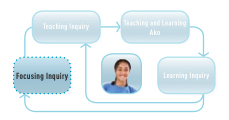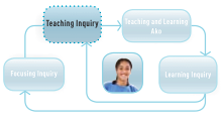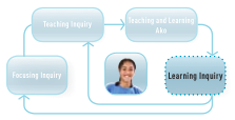Greg teaches year 8 students at a decile 6 intermediate school. His inquiry involved students in two year 8 classes, 14 percent of whom are Māori or Pasifika. One of these was his own class, and the other was a colleague’s. Greg conducted his inquiry alongside and with the support of Mike, a colleague who was also participating in QTR&D and who was inquiring into the use of drama in science teaching. Greg’s inquiry question was:
Does teaching science using Māori metaphor of ako as a teaching pedagogy help year 8 students understand scientific concepts?
Greg's focusing inquiry
What was important, given where Greg's students were at?
Greg’s initial motivation for this inquiry came from his concern that many of his students were not particularly engaged in their science learning. It was easy to get a small group interested in the experiments, but the majority tended to sit back and not participate. Greg’s Māori and Pasifika students were included in this larger group. Greg’s intended outcomes for the students were that they would develop:
- more enthusiasm about science and better engagement in their science learning;
- greater confidence to take risks;
- an improved sense of ownership of their science learning.
Greg selected a focus group of students from each of the two classes. Each group was made up of three Māori or Pasifika students and three students of other ethnicities.
'I have chosen to use focus groups so I can try to understand exactly how the children have felt about the study and hope to get open and honest answers from the children. This is good for my qualitative study, as I am not looking at numbers or percentages but exactly how the children feel and what they think went well or not. I chose to use six children in each group because any more would be hard to manage but any less may not give me enough information. I’ve noticed that in focus groups, students tend to expand on each other’s answers and are not worried about speaking once someone gets started.'
What research evidence did Greg draw on?
Greg’s reading of the report The Achievement of Māori Students (Education Review Office, 2006) confirmed that “Student engagement is a pre-requisite for student achievement, as students need to be present and engaged in learning to achieve” (page 10).
Greg’s reading also included some of the findings from the Te Kōtahitanga project. The project’s initial research shows that young Māori believe that the way their teachers relate to them as learners is fundamental to their success at school (Bishop et al., 2003).
What evidence did Greg use from his own practice or that of his colleagues?
Greg and Mike had both observed that many of their students, in particular their Māori and Pasifika students, tended to sit back and not risk making mistakes.
'We noticed that a lot of our Māori and Pasifika students weren’t taking risks. They had a fear of doing something wrong and failing. They tended to sit back and wait for a push. They wouldn’t be the first up to try something new. The thinking seemed to be, “Why bother if I’m going to fail?” We concluded that they needed more confidence.'
Greg’s teaching inquiry
What strategies were most likely to help Greg’s students learn what they needed to learn?
In discussion with Mike, Greg reflected on how his practice was contributing to his students’ engagement in their science learning.
'I felt I could make it more exciting, and then I’d be more enthused about it, and that would flow on to the kids.'
While Greg felt that he had good relationships with his students and knew them quite well, there needed to be a shift if the students were to feel confident to take the risks that are an inherent part of science learning.
The trust wasn’t there – in themselves and in us. We needed to build that relationship with the class. We needed to let our students know, “Don’t worry if it goes wrong. That’s science! You won’t always get it right.
Greg’s reading of Curriculum, Learning and Effective Pedagogy: A Literature Review in Science Education helped clarify the issues for him and indicated that it would be helpful to learn more about current New Zealand classroom practice in relation to kaupapa Māori teaching pedagogies. He was particularly interested in the concept of “ako” or “reciprocal learning”, which he sees as “developing relationships through more sharing of teaching and learning in the classroom environment”. He was also interested in this concept’s connections with other metaphors – for example, “whānau”, which is reflected in classroom relationships where people are committed to one another and take responsibility for one another’s learning.
Greg designed a unit where each class worked through five lessons on fabrics and dyes. In the first three lessons, the students looked at the properties of materials, and Greg modelled an investigative experiment. As they worked, Greg tried to develop more interactive relationships with the students by fostering conversations in which he encouraged them to share their experiences and knowledge. During these lessons, he also:
- explicitly modelled different ways of conceptualising and questioning by “thinking out loud” to reveal his thought processes (“I wonder why your school polar fleece is made of polyester?”);
- made connections to related cultural practices, for example, the use of harakeke by Māori and the creation of tapa by Pasifika peoples;
- explicitly modelled scientific processes and approaches;
- worked to embed the students’ prior experiences and knowledge in the learning and to address any misunderstandings.
In the next two lessons, the students worked in small mixed-ability groups to conduct their own experiments. They were given a list of materials they could use and asked what they wanted to find out about the materials. Greg then directed them to use their own prior knowledge and the concepts discussed in class to develop a theory they wanted to test and an experiment for testing that theory. Greg discussed each group’s plans with the group, who then conducted their experiment. Greg continued to work with the groups as required, checking in on individuals to see how they were going and what they were doing. In this way, he hoped to shift ownership and responsibility for learning to the students.
Greg chose two primary methods of data collection:
- Written questions for the students on what they had tried to find out, what they had done, and what conclusions they had drawn. Greg planned to analyse the responses to check that the students understood the scientific concepts underpinning their experiments.
- Interviews with the focus groups of students. Greg asked the students about the science unit and how it was taught to them.
What research evidence did Greg draw on?
Greg used his inquiry to better understand some of the central metaphors of a kaupapa Māori pedagogy as described by educators such as Russell Bishop and Ted Glynn. (See, for example, Bishop, 1999 and 2005; Bishop and Glynn, 1999 and 2000). These include ako, tino rangatiratanga, and whānau. Greg focused on the principle of ako and the ways in which it can change relationships in the classroom, enabling all participants in learning to share and value each other’s sense-making processes.
Rather than acting always as the “expert” who conveys information to students who receive it, the teacher is a partner in the “conversation” of learning.
Bishop and Glynn, 2000, page 4
Greg was interested in the interrelationships between the metaphors, for example, between ako and whānau, which Bishop and Glynn describe as:
a pattern of interactions [that] will develop where commitment and connectedness are paramount, and where responsibility for the learning of others is
fostered.
2000, page 5
Greg read Curriculum, Learning and Effective Pedagogy: A Literature Review in Science Education, in which Hipkins and her colleagues unpack some of the metaphors of kaupapa Māori pedagogy. They raise provocative questions that challenge some common assumptions, such as the idea that all Māori children prefer to work in groups. They conclude that “Metaphors described for Kaupapa Māori pedagogy could be used to help meet the equity challenges associated with science education in New Zealand schools” (page 198).
Greg linked his new understandings of ako to other literature about the value of a constructivist approach in education, which emphasises the importance of student–teacher dialogue and asserts that the teacher must be a learner alongside the students. For example, Greg read Maor’s description of a multimedia professional development programme aimed at developing participating teachers’ understanding of constructivism in science education. Maor reports that:
The teachers’ experiences as learners provided them with a better understanding of the learning process and helped them model teaching pedagogies appropriate for students working in a constructivist- orientated, inquiry-based multimedia learning environment.
1999, page 49
What evidence did Greg use from his own practice or that of his colleagues?
Greg and Mike both felt that the issues in their own practice were echoed across the school.
Science wasn’t taught that well. It tends to be a subject where, if something else comes up, people feel they can just skip it. It hasn’t been a priority for teachers. It needs to become a priority, and we need to convey a sense of enthusiasm. This rubs off on the students – they won’t be interested if we’re not.
Greg focused on the principle of ako and the ways in which it can change relationships in the classroom, enabling all participants in learning to share and value each other’s sense-making processes.
Greg’s learning inquiry
What happened as a result of Greg’s teaching, and what are the implications for his future teaching?
The students’ written responses to Greg’s questions showed that they were able to describe what they had done in their experiments and why. The responses also showed that the students could suggest explanations for their results. This indicated that they did understand the scientific concepts they had been exploring. Greg noticed two points of interest:
- The students for whom English was a second language had difficulty in expressing themselves in writing. Greg realised that an oral evaluation might have been more suitable for checking their understanding of concepts.
- While some of the groups chose to test similar theories, they all tested them in different ways.
Discussion with the focus groups yielded the following findings:
- A majority of students in both groups thought that they were effectively taught the concepts in this unit.
- Trust was very important for the students, and they appreciated the opportunity to conduct their experiments independently in their groups.
- They enjoyed the group work, but some were annoyed when a group member didn’t fully participate and yet got the same marks as those who did.
- Two students said that they used prior knowledge in their experiments, but neither could recall where that information had come from.
- While some of the students initially found the “thinking out loud” approach quite strange, it did help them to understand what they should be doing.
- All the students said that the teacher modelling was important.
- They thought it was valuable for teachers to try new teaching approaches.
Greg concluded that his use of explicit modelling had been effective. He also felt that by taking risks himself and listening to his students more carefully, he had built a greater sense of whānau in each class. This in turn had enabled him to begin to enact the principle of ako. Through understanding their perspectives, Greg had learned from the students and been able to build on the knowledge they had brought to the classroom. Giving the students greater ownership of their learning had empowered them to become active participants in the learning, and the relationship between him and them had been further strengthened. Trust and respect were essential elements of this relationship.
I already knew the kids well, but building this kind of trust is different. Modelling the thinking out loud seemed really weird to the kids. You’ve got to let the kids have a laugh. If you show yourself taking risks, then they feel safer to take risks and they try to give a bit more back … The kids get to know you. They know how you’ll react. If the experiment goes wrong, they know that’s not something they have to worry about. You won’t flip out … It’s also really valuing what they have to bring to the conversation.
Greg found that there had been a change in the way he and his students talked to each other.
You become a bit more relaxed in the way you talk to them when the relationship is strengthened. You still need to use the language of science, but you don’t have to know all the answers. You can take a step back, and get an idea, and let the kids run with it. You can let the kids come up with ideas for you. Let them bring the context to you and tell you about it. Put ideas in their minds, and let them group them and come up with their own ideas. Get them really thinking!
Greg found it very helpful to be able to bounce ideas off Mike and discuss what had and hadn’t worked, especially when they were puzzled about the students’ responses. He acknowledges some limitations in this study, notably the limited sample of students and, in particular, the limited number who were Māori or Pasifika. He was disappointed that the Māori and Pasifika students didn’t respond specifically to the deliberate connections he made to Māori and Pasifika cultural knowledge. Nevertheless, the results were encouraging.
It was clear that students warmly received the use of a different teaching style. They commented on the change and the enjoyment gained from the change. It was also clear that it was not just the Māori and Pasifika children who would benefit from the use of different teaching pedagogies but that all children would benefit.
What research evidence did Greg draw on?
Greg returned to Hipkins et al.’s literature review (2002) to reflect on the results of his inquiry.
In analysing his findings, he referred to Denzin and Lincoln’s handbook on qualitative research:
Qualitative research is multi-method in focus, involving an interpretative, naturalistic approach to its subject matter. This means that qualitative researchers study things in their natural settings, attempting to make sense of, or interpret, phenomena in terms of the meanings people bring to them.
2000, page 3
Greg concluded that his inquiry question had required him to focus on the subjects of his inquiry – the students – and that the qualitative methods he’d adopted had enabled him to make sense of what was happening in terms of their experiences.
What evidence did Greg use from his own practice or that of his colleagues?
The following comments reveal some student perspectives on the teaching and learning:
'You thought out loud. And you didn’t just write it up on the board. You were telling us what you were doing and we were like, “Oh yeah, sweet!”
'Like, in year 7, we saw Miss __ do all the science, and we didn’t get to do much, but this was pretty cool. And it was sort of different experiments … like chucking jellybeans in water and watching dye come out; it was different from last year.'
'I liked the last bit the best because everyone actually got to do different things, and you could find out from different groups about what they did and what they learned.'
'I think it was good because when you just get to do writing and boring stuff, then you don’t really take it in as much as hands-on stuff; if you make it fun, then people will pay more attention to it. I think you did a good job.'
'It was clear that students warmly received the use of a different teaching style. They commented on the change and the enjoyment gained from the change. It was also clear that it was not just the Māori and Pasifika children who would benefit from the use of different teaching pedagogies but that all children would benefit.'
What happened next?
Following the inquiry, Greg found that there had been a change in classroom dynamics. In particular, he noticed that the students had got better at listening to each other. They seemed to be more aware that they could check their thinking and spark new ideas by finding out what others were thinking.
Greg plans to continue with his inquiry into the factors that influence students’ understandings in science. He is continuing to work on involving students more in science by encouraging them to take risks and to experiment. In a recent unit, for example, the students looked at flight. After careful scaffolding, they had the opportunity to build and test the “perfect model airplane”.
Greg’s and Mike’s inquiries have had an effect across the school. Together they have reviewed the school’s science curriculum and discarded a number of unit plans that were based on teachers dispensing knowledge to their students. These have been replaced with new plans in which teacher and students work together to co-construct knowledge, for example, by growing gardens. There is a new enthusiasm for science in the school amongst both teachers and students.
Reflective questions
What questions does this story raise for you and your colleagues about:
- the importance of student engagement in learning?
- the principle of ako and how it links to a constructivist pedagogy of science education?
- the role of trust in building reciprocal relationships that empower learning?
- the “messages for the mainstream” that emerge from kaupapa Māori pedagogy?
- what engages students and how this aligns with your existing beliefs and practices?
- appropriate assessment procedures for students for whom English is a second language?
References
Bishop, R. (1999). Investigating Culturally Relevant Pedagogies for Māori. Paper presented at the Innovations for Effective Schooling Conference, University of Waikato, School of Education.
Bishop, R. (2005). Addressing Education for International Understanding in New Zealand. Journal of Education for International Understanding, vol. 1, pp. 109–125.
Bishop, R., Berryman, M., Tiakiwai, S., and Richardson, C. (2003). Te Kōtahitanga: The Experiences of Year 9 and 10 Māori Students in Mainstream Classrooms. Wellington: Ministry of Education.
Bishop, R. and Glynn, T. (1999). Culture Counts: Changing Power Relations in Education. Palmerston North: Dunmore Press.
Bishop, R. and Glynn, T. (2000). Kaupapa Māori Messages for the Mainstream. Set: Research Information for Teachers, no. 1, pp. 4–7.
Denzin, N. K. and Lincoln, Y. S. (2000). Introduction: The Discipline and Practice of Qualitative Research. In Handbook of Qualitative Research, 2nd ed., ed. N. K. Denzin and Y. S. Lincoln. Thousand Oaks, Calif.: Sage.
Education Review Office (2006). The Achievement of Māori Students. Wellington: ERO.
Hipkins, R., Bolstad, R., Baker, R., Jones, A., Barker, M., Bell, B., Coll, R., Cooper, B., Forret, M., Harlow, A., Taylor, I., France, B., and Haigh, M. (2002). Curriculum, Learning and Effective Pedagogy: A Literature Review in Science Education. Wellington: Ministry of Education.
Maor, D. (1999). Teachers-as-learners: The Role of a Multimedia Professional Development Program in Changing Classroom Practice. Australian Science Teachers Journal, vol. 45 no. 3, pp. 45–50.
Published on: 26 Aug 2009
Return to top





